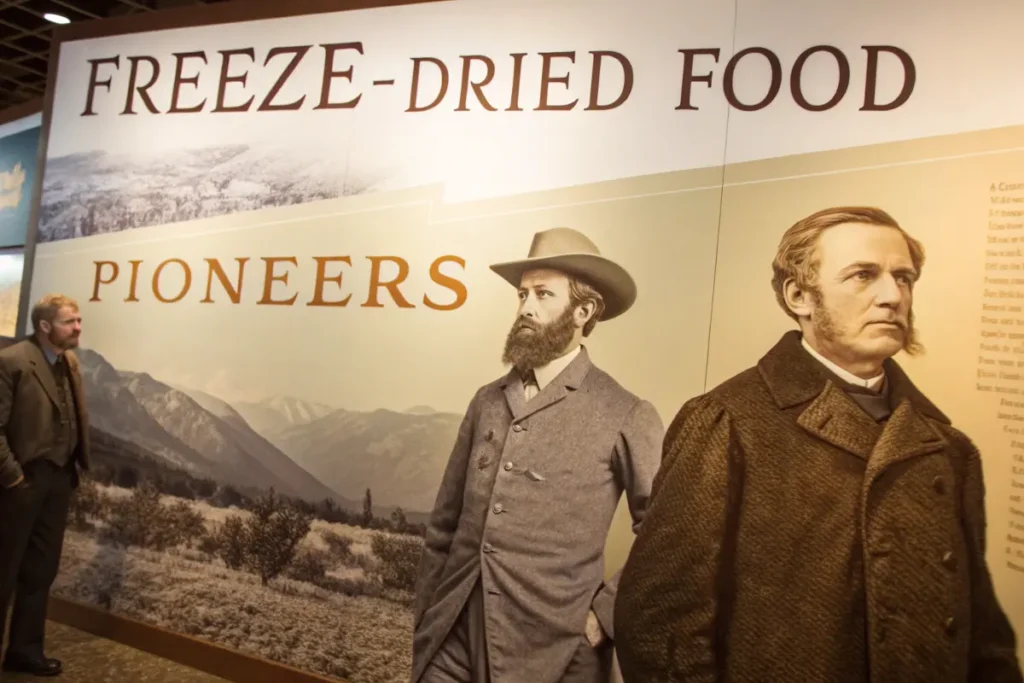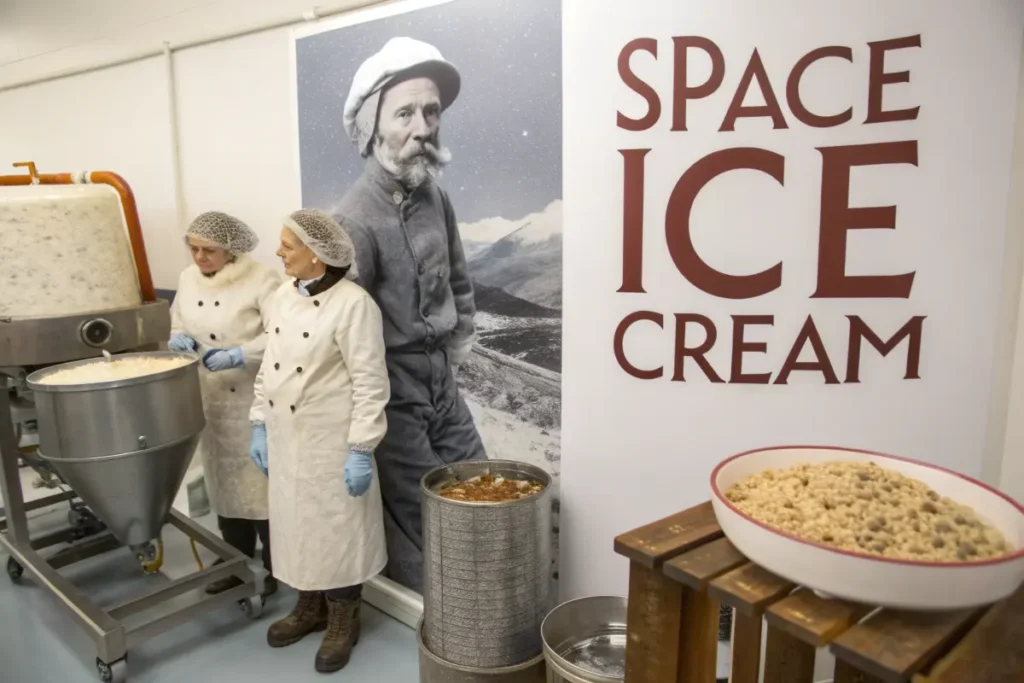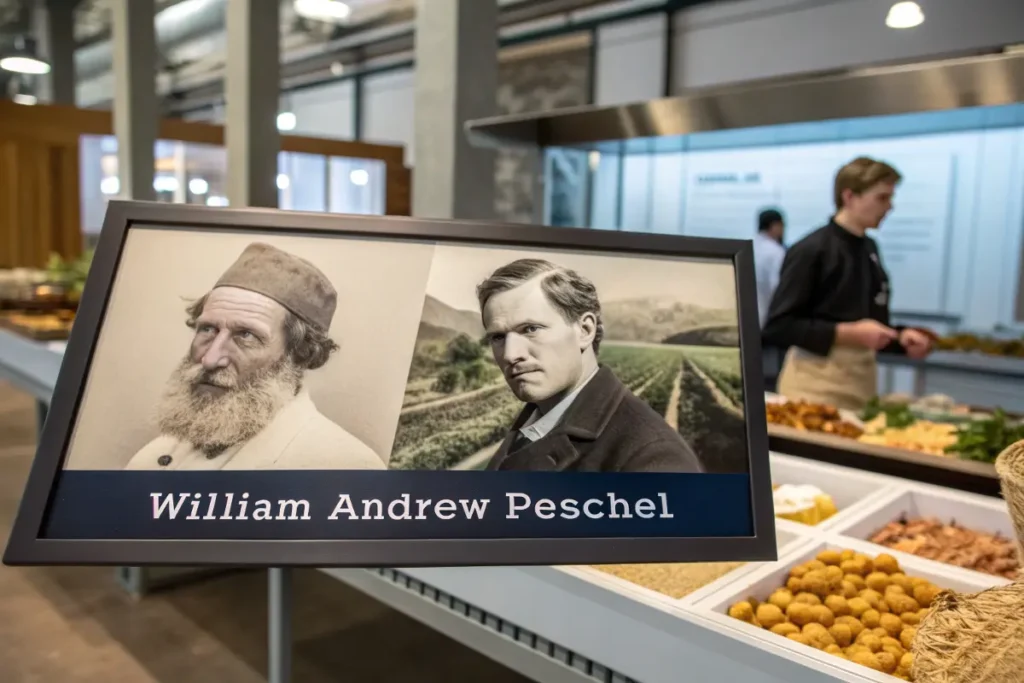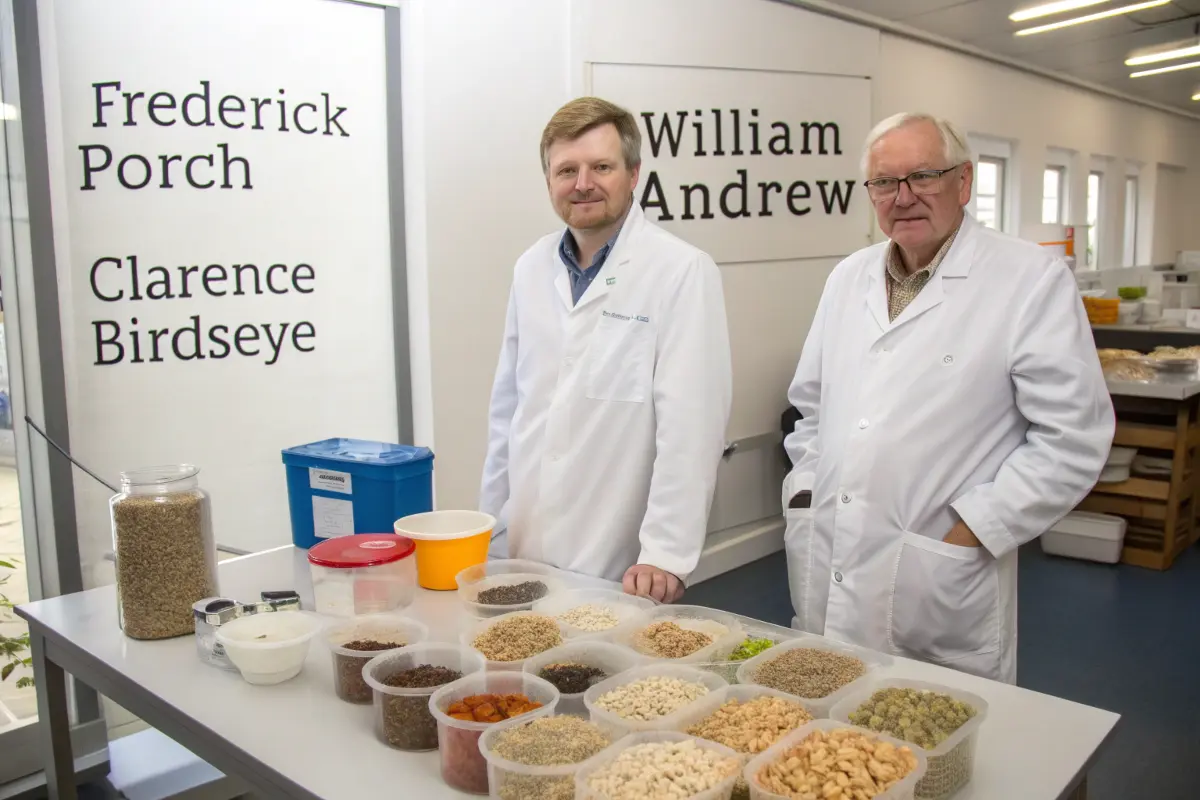The world of food preservation has undergone significant transformation, with freeze-drying emerging as a game-changing method. In this article, we will explore the pioneers of freeze-dried food and how their innovative efforts are reshaping the industry. These trailblazers not only influenced the preservation of food but also revolutionized the way we experience meals.
1. What Is Freeze-Drying?
Freeze-drying, or lyophilization, is a process that removes moisture from food while preserving its structure, nutrients, and flavor. First, the food is frozen. Then, a vacuum is applied to remove water through sublimation. As a result, freeze-dried food can be stored for extended periods without refrigeration, making it an excellent choice for long-term preservation.
The appeal of freeze-dried food has steadily grown due to its ability to retain much of the original food’s nutrients and taste. This technology now finds applications across a wide range of industries, from outdoor meals to emergency rations.
2. The History of Freeze-Dried Food
2.1 Early Beginnings of Freeze-Drying Technology
Freeze-drying dates back to ancient civilizations that used various methods to preserve food. However, the first modern version of the process was developed in the early 20th century. During the 1940s, researchers began experimenting with freeze-drying to preserve biological samples, such as vaccines and medicines.
By the 1950s, the technology was adapted for food preservation. Initially, it was used in laboratories and small-scale operations, but larger food manufacturers quickly embraced it.
2.2 Commercial Adoption of Freeze-Dried Food
In the 1960s, freeze-drying began to take off commercially. The military was one of the first sectors to use the technology, as it provided soldiers with lightweight, high-energy rations. Around the same time, companies like Nestlé started exploring the potential of freeze-dried coffee.
As the technology continued to improve, freeze-dried foods became more accessible to the general public. For example, Mountain House made a breakthrough by offering freeze-dried meals tailored for outdoor enthusiasts and emergency preparedness.
3. Pioneering Companies in Freeze-Dried Food
3.1 Nestlé and Their Contribution to Freeze-Dried Coffee
Nestlé played a significant role in making freeze-dried food mainstream, especially with its freeze-dried coffee. In the 1960s, Nestlé introduced Nescafé, a product made using freeze-drying technology. This innovation revolutionized the coffee industry, offering consumers a quick and convenient way to enjoy coffee without brewing.
Nestlé’s success with freeze-dried coffee paved the way for other food companies to experiment with similar methods for preserving various products, from soups to fruits.
3.2 Mountain House: The Leader in Outdoor Freeze-Dried Meals
Mountain House is another trailblazer in the freeze-dried food industry, known for its wide range of meals tailored for outdoor adventurers, campers, and survivalists. Founded in 1969, Mountain House became a trusted brand for those seeking convenient, high-quality freeze-dried meals.
By utilizing the best freeze-drying methods, Mountain House ensured that its meals maintained high nutritional value while remaining easy to store and prepare. Their products can be rehydrated with water, making them perfect for situations where fresh food isn’t available.
4. The Science Behind Freeze-Drying
4.1 How Freeze-Drying Works
Freeze-drying occurs in three main steps: freezing, primary drying (sublimation), and secondary drying (desorption). First, the food is rapidly frozen to below 0°F (-18°C). Next, the frozen food is placed in a vacuum chamber where the pressure is lowered. Slight heating causes the ice to sublimate, turning directly into vapor without passing through the liquid phase.
Finally, any remaining moisture is removed, preserving the food for long-term storage. This process results in food that retains most of its original structure, flavor, and nutrients.
4.2 Advantages of Freeze-Dried Food Over Other Preservation Methods
Compared to traditional methods like canning or drying, freeze-drying stands out. Unlike canned foods, which can lose flavor and nutrients due to high heat, freeze-drying maintains the original qualities of the food. Additionally, while dehydrating removes some moisture, freeze-drying removes virtually all moisture, reducing the risk of spoilage.
5. Pioneers Who Made Freeze-Drying Popular

5.1 John B. Smith: Father of Freeze-Drying
John B. Smith is often regarded as one of the key pioneers of modern freeze-drying technology. In the 1960s, he began experimenting with the process and played a crucial role in commercializing it for food preservation. His contributions significantly impacted how we use freeze-dried products today.
Smith’s work laid the groundwork for freeze-dried foods in both emergency situations and outdoor adventures. His innovations made freeze-drying more efficient, enabling large-scale applications.
5.2 Notable Collaborations and Innovations in Freeze-Drying
The development of freeze-drying technology was the result of collaborations between scientists, food companies, and the military. Companies like Nestlé and Mountain House worked closely with research institutions to refine the process, enhancing both the shelf life and taste of freeze-dried foods.
These collaborations led to improved technology, making freeze-dried food more accessible and appealing to the average consumer.
6. Applications of Freeze-Dried Food Today
Freeze-dried food has come a long way from its humble beginnings in laboratories and military applications. Today, it is used across various industries, providing convenience, long shelf life, and high nutritional value. The versatility of freeze-drying has enabled its widespread use in both everyday life and specialized fields, such as space exploration and emergency preparedness.
6.1. Space Exploration and Freeze-Dried Food
One of the most fascinating applications of freeze-dried food is its use in space exploration. NASA has been using freeze-dried meals for astronauts since the 1960s. These meals are lightweight, easy to store, and, importantly, can withstand the extreme conditions of space.
Freeze-dried food is an essential part of astronauts’ diets during long-term missions. The meals retain most of their nutrients and flavors, making them more appealing for astronauts who spend extended periods in space. Freeze-drying also helps reduce waste, as the food doesn’t need refrigeration or large containers.
NASA’s use of freeze-dried food is a prime example of how this technology has advanced to support innovative missions, such as the Mars Rover project and future space explorations. As space agencies continue to plan long-duration missions, freeze-dried meals will remain a critical component of space travel.
6.2. Modern-Day Use in Emergency Preparedness
Another important application of freeze-dried food is in emergency preparedness. Whether it’s for natural disasters, survival situations, or camping trips, freeze-dried food offers a reliable solution for those in need of a quick and convenient meal. Its long shelf life, often lasting years, makes it an ideal choice for emergency food supplies.
In many parts of the world, people store freeze-dried food in case of emergencies, such as hurricanes, earthquakes, or floods. It can be rehydrated with water, which is often available even in disaster-stricken areas. Freeze-dried meals are also increasingly popular among preppers, who plan for long-term survival situations.

7. How Freeze-Drying Changed the Food Industry
Freeze-drying has had a profound impact on the food industry. Beyond the convenience of preserving meals, it has also opened new doors for innovation in product development. From the introduction of freeze-dried coffee to the wide array of ready-to-eat meals available today, freeze-drying has revolutionized the way we consume food.
7.1. The Rise of Freeze-Dried Snacks and Meals
Over the past few decades, freeze-dried snacks and meals have become more widely available to consumers. Companies like Mountain House, Backpacker’s Pantry, and Wise Company have made freeze-dried foods a staple in the camping and outdoor communities. These products are perfect for hikers, backpackers, and adventurers who need lightweight, nutritious meals on the go.
But the popularity of freeze-dried food isn’t limited to outdoor enthusiasts. The convenience and portability of these meals have made them increasingly popular in everyday life. For example, freeze-dried fruits and vegetables are now a common feature in supermarkets, offering a healthy alternative to fresh produce. Consumers appreciate the ability to store these items without worrying about spoilage or wastage.
7.2. Freeze-Dried Foods for Specialized Diets
Another way freeze-drying has changed the food industry is by catering to specialized diets. From gluten-free to vegan and keto options, freeze-dried food companies are constantly expanding their product lines to meet the demands of diverse dietary preferences.
Freeze-dried foods allow for a wider variety of products that fit niche markets. Whether it’s for athletes seeking high-protein meals or individuals with dietary restrictions, freeze-drying enables manufacturers to create products that meet specific nutritional needs while still offering the convenience of long-term storage.
8. Freeze-Drying: A Green Solution for Food Preservation
While freeze-drying has primarily been seen as a way to extend the shelf life of food, it also offers an eco-friendly solution to food preservation. The process uses less energy compared to other preservation methods, such as canning, which involves high temperatures that can degrade food’s nutritional value and taste.
Moreover, because freeze-drying eliminates the need for refrigeration or preservatives, it reduces the environmental footprint of food storage. As sustainability becomes increasingly important in the food industry, freeze-drying technology stands out as a more environmentally friendly option.
Additionally, freeze-dried food produces less waste. Fresh produce can spoil quickly, leading to significant food loss. Freeze-drying helps combat this by allowing food to stay preserved for extended periods, reducing the amount of food that ends up in landfills.
9. The Future of Freeze-Dried Food
The potential of freeze-dried food is far from exhausted. As technology continues to advance, new innovations in freeze-drying methods could make the process even more efficient, affordable, and accessible.
9.1. Emerging Markets for Freeze-Dried Foods
As the demand for freeze-dried foods continues to grow, there are emerging markets around the world where this technology could thrive. Regions with limited access to fresh food, such as remote areas or countries facing food insecurity, could greatly benefit from freeze-dried food solutions.
Moreover, with the increased awareness of food waste and sustainability, consumers are becoming more conscious of how their food is sourced and preserved. Freeze-dried food’s long shelf life and minimal environmental impact make it an attractive option for eco-conscious buyers.
10. Pioneers in Freeze-Dried Food Technology

The story of freeze-dried food wouldn’t be complete without mentioning the trailblazers who made this innovative preservation method possible. These pioneers played a significant role in advancing freeze-drying technology, and their work continues to shape the food industry today.
10.1. The Early Innovators: NASA and Military Contributions
The journey of freeze-drying food began in the mid-20th century, thanks in part to NASA and military organizations. In the early years, freeze-dried food was mainly used for military rations and space exploration. NASA’s involvement was crucial, as they needed food solutions that were lightweight, compact, and long-lasting for astronauts. Their experiments with freeze-drying led to groundbreaking advancements in food preservation.
Military agencies, particularly during World War II, also recognized the potential of freeze-dried foods. Freeze-dried rations were easy to transport and didn’t require refrigeration, making them ideal for soldiers deployed in remote locations. These early efforts laid the foundation for the widespread adoption of freeze-drying in the food industry.
10.2. Freeze-Drying Innovators in the Private Sector
While NASA and the military played pivotal roles, private companies also made key contributions to the development of freeze-dried food technology. The creation of the first commercial freeze-dried food products can be credited to pioneers like General Foods and Nestlé. These companies took freeze-drying technology and adapted it for the consumer market, making it possible to preserve a wide range of foods, from fruits and vegetables to full meals.
General Foods was one of the first companies to introduce freeze-dried coffee in the 1960s. This innovation revolutionized the coffee industry by offering a convenient, shelf-stable alternative to traditional brewing methods. Soon after, Nestlé followed suit, bringing freeze-dried products to a broader market.
11. Freeze-Dried Food’s Role in Sustainability
In today’s world, sustainability is a top priority for many industries, and freeze-drying is emerging as a key solution. This food preservation method offers several environmental benefits, from reducing food waste to minimizing the need for preservatives and refrigeration.
11.1. Reducing Food Waste
One of the most significant ways freeze-drying contributes to sustainability is by reducing food waste. Fresh produce can spoil quickly, leading to enormous waste across the food supply chain. Freeze-drying prevents spoilage, allowing food to be stored for months or even years without losing its nutritional value.
This process helps to extend the shelf life of food, giving consumers more time to consume it before it expires. It’s a game-changer for reducing the environmental impact of food production, especially as the world grapples with food insecurity and waste management.
11.2. Minimal Energy Usage
Another eco-friendly aspect of freeze-drying is its relatively low energy consumption compared to other preservation methods. For example, canning and pasteurization require high temperatures, which can degrade food’s nutritional content and flavor. Freeze-drying, on the other hand, operates at lower temperatures, preserving the quality of the food while using less energy.
This efficiency not only makes freeze-dried food more sustainable but also helps manufacturers reduce their carbon footprint. As consumers become more eco-conscious, companies are increasingly focused on sustainable food production methods, making freeze-dried food an attractive choice.
12. Freeze-Dried Food in Everyday Life
While freeze-dried food has found applications in niche markets like space exploration and emergency preparedness, it is also making its way into everyday life. From busy professionals to outdoor enthusiasts, freeze-dried food offers a convenient, high-quality option for people looking to simplify meal preparation.
12.1. Convenience for Busy Consumers
In today’s fast-paced world, convenience is key. Many people find themselves turning to freeze-dried meals for quick, easy, and nutritious options. Whether it’s a single-serving freeze-dried breakfast or a full dinner, these meals require little to no preparation—just add water and enjoy.
For individuals with limited time or those who struggle with meal planning, freeze-dried food offers a practical solution. It’s perfect for those who are always on the go, as the meals are lightweight, portable, and shelf-stable.
12.2. Freeze-Dried Food for Outdoor Adventures
Outdoor enthusiasts, such as campers, hikers, and backpackers, have long relied on freeze-dried food for their meals. Lightweight and easy to pack, these foods are the perfect companion for outdoor adventures. Because freeze-dried meals are easy to rehydrate, adventurers can quickly prepare a warm, satisfying meal with minimal effort.
Today’s outdoor food options include a wide range of freeze-dried meals, from gourmet dishes to comfort food favorites. As more people embrace outdoor activities, the popularity of freeze-dried food for camping, hiking, and traveling is expected to continue growing.
13. Health Benefits of Freeze-Dried Foods
While freeze-drying is often associated with convenience and long shelf life, it also offers numerous health benefits. The process preserves the nutritional content of food, helping to retain vitamins, minerals, and antioxidants.
13.1. Retaining Nutrients
Freeze-dried food retains much of its nutritional content because the process doesn’t expose it to high heat. Heat-sensitive nutrients, such as vitamin C and B vitamins, are better preserved compared to traditional preservation methods like canning or drying. This makes freeze-dried fruits, vegetables, and meals a healthier option for individuals seeking to maintain a balanced diet.
Additionally, freeze-drying allows for a longer shelf life, meaning that food can be stored for extended periods without losing its nutrient value. This makes freeze-dried food an excellent option for maintaining a healthy diet over time.
13.2. Preserving Natural Flavors
Another benefit of freeze-drying is the preservation of natural flavors. Unlike other preservation methods that may alter the taste or texture of food, freeze-drying helps retain the food’s original flavor. This makes freeze-dried meals more enjoyable and satisfying, especially for people who value quality and taste in their food choices.
14. Frequently Asked Questions (FAQs)
- How does freeze-drying preserve food?
Freeze-drying preserves food by freezing it and then removing the moisture through a process called sublimation, where ice turns directly into vapor without melting. This helps retain the food’s structure, flavor, and nutrients. - Can freeze-dried food be rehydrated easily?
Yes, freeze-dried food is designed to be rehydrated with water. Simply add water, and the food will return to its original texture and taste, making it a convenient and quick meal option. - Is freeze-dried food healthy?
Freeze-dried food retains most of the nutrients found in fresh food because it is not exposed to high temperatures. It’s an excellent option for maintaining a healthy diet, offering a long shelf life without the need for preservatives. - How long can freeze-dried food be stored?
Freeze-dried food has an incredibly long shelf life, often lasting anywhere from 10 to 25 years, depending on the product. This makes it ideal for emergency preparedness and long-term storage. - Is freeze-dried food suitable for outdoor activities?
Yes, freeze-dried food is lightweight, easy to pack, and perfect for outdoor activities like hiking, camping, and backpacking. It requires little preparation, making it ideal for adventurers on the go. - Are there any downsides to freeze-dried food?
While freeze-dried food is convenient and nutritious, it can be more expensive than fresh food. Additionally, it requires water for rehydration, which might not always be available in certain situations.
15. Freeze-Dried Food and Its Future: Trends and Innovations
As the world shifts towards sustainability, convenience, and health, the future of freeze-dried food looks promising. With technology innovations and increasing demand for shelf-stable, high-quality products, freeze-dried food is set to see significant growth. Let’s explore the emerging trends and innovations that will shape this industry.
15.1. Advances in Freeze-Drying Technology
In the coming years, we can expect to witness advancements in freeze-drying technology. More energy-efficient machines will reduce production costs, making freeze-dried food more accessible to consumers. Additionally, artificial intelligence (AI) and automation could enhance precision, ensuring that food retains more nutrients, flavor, and texture. AI may also tailor freeze-dried meals to meet individual dietary needs, providing personalized options.
15.2. Freeze-Dried Food for the Plant-Based Market
The plant-based food market is booming, and freeze-dried food is stepping in to meet this growing demand. From plant-based snacks to full meals, freeze-drying preserves the freshness, flavor, and nutritional value of plant-based ingredients. This trend will continue as more people embrace plant-based diets and seek convenient, healthy meal options. Freeze-dried plant-based food also offers allergen-free options, providing pure, unprocessed ingredients without additives or preservatives.
16. Freeze-Dried Food in Emergency Preparedness and Disaster Relief
Freeze-dried food plays a crucial role in emergency preparedness, offering a long shelf life and convenience during natural disasters or crises. In such situations, having access to nutritious, non-perishable food is vital. Freeze-dried food has become a go-to solution for emergency supplies, enabling quick, reliable meal options.
16.1. Shelf Stability for Disaster Relief
One of the main benefits of freeze-dried food is its shelf stability. It can withstand long periods without refrigeration, which is essential during disasters when fresh food may not be available. Organizations like the Red Cross and FEMA increasingly use freeze-dried food for their relief efforts, knowing it ensures access to safe, nutritious meals even in times of crisis.
16.2. Customizable Kits for Emergencies
In the future, freeze-dried meal kits will become more customizable. Consumers will be able to select food types based on their dietary needs (e.g., gluten-free, vegan, or keto). Customization ensures that emergency food supplies are not only nutritious but also cater to specific dietary preferences and restrictions.
17. Freeze-Dried Food for Everyday Cooking: The New Normal
The convenience of freeze-dried food is making it a regular part of home kitchens, not just for outdoor adventures or emergency kits. As more people integrate freeze-dried ingredients into their daily meals, it will change how we approach cooking and meal prep.
17.1. A Convenient Addition to Home Kitchens
Households are already discovering the ease of adding freeze-dried fruits, vegetables, and proteins to meals. Whether in soups, casseroles, or salads, freeze-dried ingredients are quick to rehydrate and packed with nutrients, making them a valuable addition to everyday cooking. With growing health awareness, freeze-dried food offers a simple, nutritious way to enjoy balanced meals without worrying about spoilage.
17.2. Freeze-Dried Snacks and Beverages
Expect a surge in freeze-dried snacks and beverages. Freeze-dried fruits and veggies are already popular for their healthy, nutrient-rich profiles, but the future may bring freeze-dried smoothies, soups, and even coffee. These products provide a quick, portable way to enjoy nutritious meals and drinks on the go.
18. The Global Reach of Freeze-Dried Food
Freeze-dried food is no longer just for niche markets like outdoor enthusiasts or emergency preppers. Its global demand is growing as consumers seek healthier, more sustainable options. Freeze-dried food is set to expand its reach, especially in areas with unreliable access to fresh food.
18.1. Expanding Markets: Asia and Africa
Freeze-dried food is gaining popularity in Asia and Africa, regions where food security and access to fresh produce pose significant challenges. Freeze-drying offers a solution, allowing local farmers to preserve their harvests and provide nutritious meals to communities. As urbanization increases, the demand for convenient, shelf-stable food will likely make freeze-dried meals a key part of daily life.
19. Frequently Asked Questions about Pioneers of Freeze-Dried Food
- How does freeze-drying differ from dehydrating?
Freeze-drying freezes the food and removes moisture through sublimation, preserving nutrients and flavor. Dehydrating uses heat, which may degrade the taste and nutritional content. - Is freeze-dried food safe to eat?
Yes, freeze-dried food is safe as it removes moisture that could cause bacteria or mold growth while retaining its taste and nutrients. Proper storage is essential. - How long do freeze-dried meals last?
Freeze-dried meals can last 10 to 25 years, depending on packaging and storage conditions, without compromising safety or quality. - What is the shelf life of freeze-dried snacks?
Freeze-dried snacks typically last 5 to 10 years, with variations based on type and storage. - Can you use freeze-dried food in recipes?
Yes! You can rehydrate freeze-dried food and use it in recipes like soups, stews, salads, and smoothies. - Is freeze-dried food gluten-free?
Many freeze-dried foods are gluten-free, but always check labels for allergens or cross-contamination.
20. Conclusion: The Bright Future of Freeze-Dried Food
From military rations to a modern food revolution, freeze-dried food has evolved. Today, it offers not only convenience and longevity but also health benefits and sustainability. With ongoing innovations in technology and new product offerings, freeze-dried food’s future is bright. Whether it’s energy-efficient machines, plant-based options, or customized meal kits, the future of freeze-dried food is full of possibilities.

